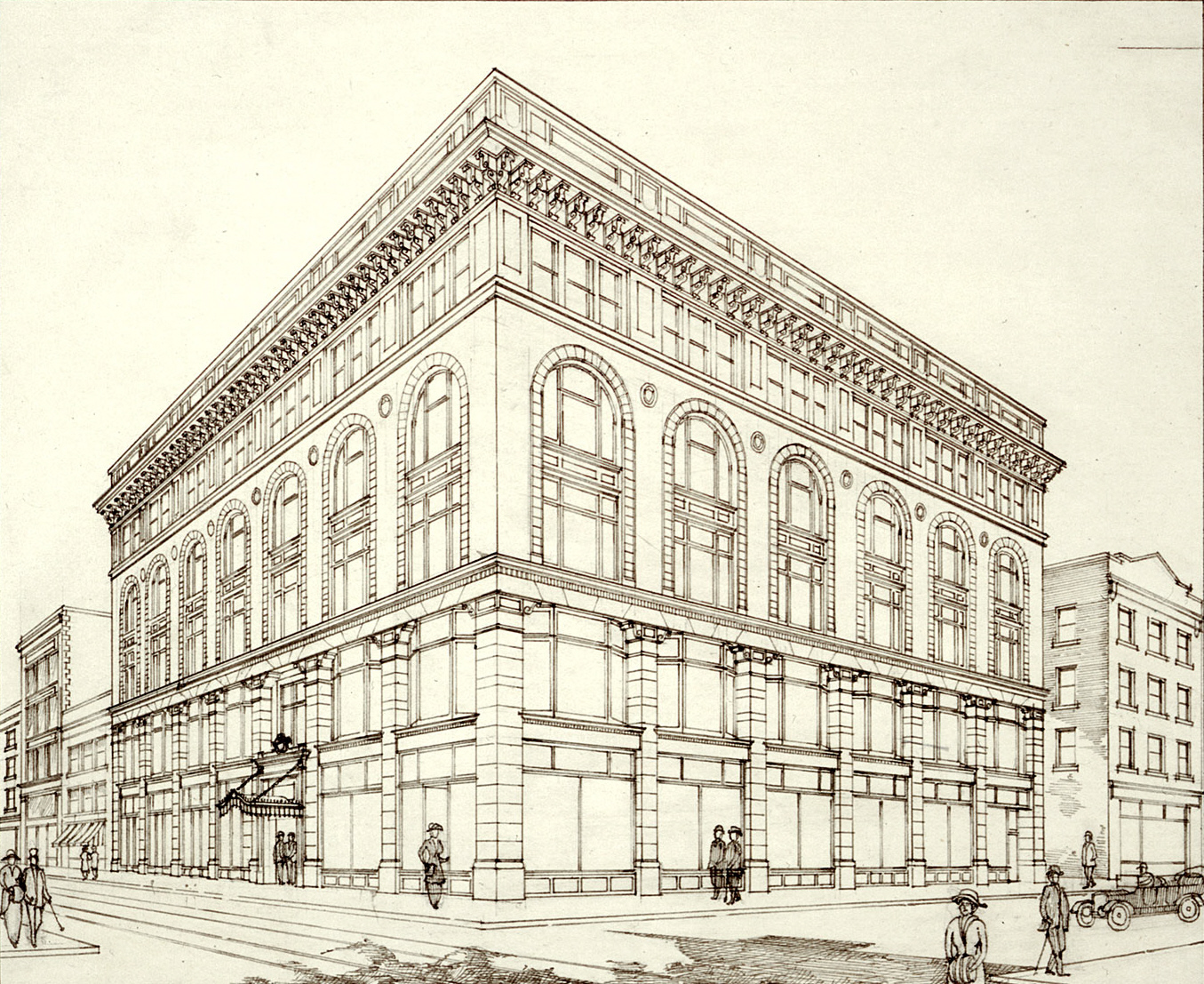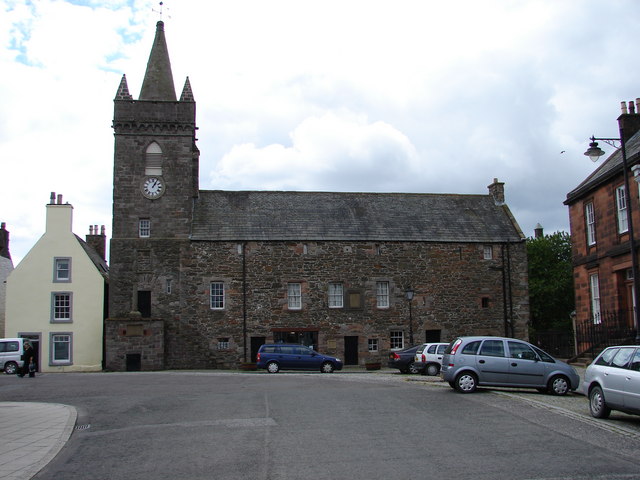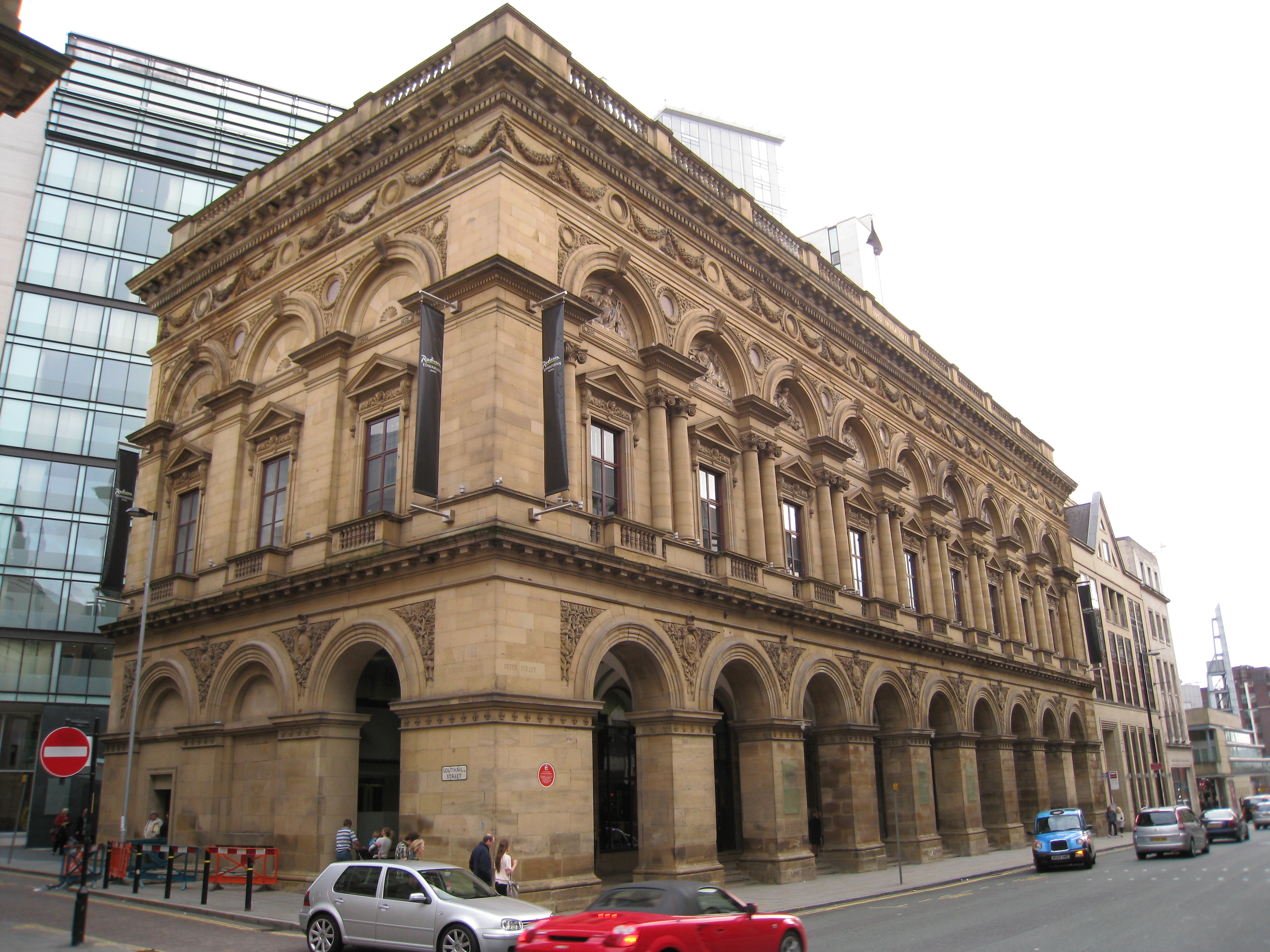|
Milligan And Forbes Warehouse
The Milligan and Forbes Warehouse in Bradford, West Yorkshire, England is a grade II listed building built as the eponymous stuff merchants' warehouse in the 19th century. It is considered the city's first building in the Palazzo style and was very influential on 19th century Bradford architecture. History Robert Milligan was born in Kirkcudbright, Dumfries and Galloway on 10 October 1786. He settled in Bradford in about 1810 and established a drapers shop in Kirkgate, eventually beginning a career as a stuff merchant. He became head of the firm of ''Milligan, Forbes and Co'' that became synonymous with the stuff trade in Bradford. Milligan was the first Mayor of Bradford (1847–48) and subsequently Liberal M.P. for the borough in three successive Parliaments between 1851 and 1857. His partner, London traveller Henry Forbes was also mayor of Bradford in 1849–50. The firm decided to build a new warehouse for home trade and a site was purchased on Hall Ings next to t ... [...More Info...] [...Related Items...] OR: [Wikipedia] [Google] [Baidu] |
Bradford
Bradford is a city and the administrative centre of the City of Bradford district in West Yorkshire, England. The city is in the Pennines' eastern foothills on the banks of the Bradford Beck. Bradford had a population of 349,561 at the 2011 census; the second-largest population centre in the county after Leeds, which is to the east of the city. It shares a continuous built-up area with the towns of Shipley, Silsden, Bingley and Keighley in the district as well as with the metropolitan county's other districts. Its name is also given to Bradford Beck. It became a West Riding of Yorkshire municipal borough in 1847 and received its city charter in 1897. Since local government reform in 1974, the city is the administrative centre of a wider metropolitan district, city hall is the meeting place of Bradford City Council. The district has civil parishes and unparished areas and had a population of , making it the most populous district in England. In the century lea ... [...More Info...] [...Related Items...] OR: [Wikipedia] [Google] [Baidu] |
West Yorkshire
West Yorkshire is a metropolitan and ceremonial county in the Yorkshire and Humber Region of England. It is an inland and upland county having eastward-draining valleys while taking in the moors of the Pennines. West Yorkshire came into existence as a metropolitan county in 1974 after the reorganisation of the Local Government Act 1972 which saw it formed from a large part of the West Riding of Yorkshire. The county had a recorded population of 2.3 million in the 2011 Census making it the fourth-largest by population in England. The largest towns are Huddersfield, Castleford, Batley, Bingley, Pontefract, Halifax, Brighouse, Keighley, Pudsey, Morley and Dewsbury. The three cities of West Yorkshire are Bradford, Leeds and Wakefield. West Yorkshire consists of five metropolitan boroughs ( City of Bradford, Calderdale, Kirklees, City of Leeds and City of Wakefield); it is bordered by the counties of Derbyshire to the south, Greater Manchester to the south-west, La ... [...More Info...] [...Related Items...] OR: [Wikipedia] [Google] [Baidu] |
England
England is a country that is part of the United Kingdom. It shares land borders with Wales to its west and Scotland to its north. The Irish Sea lies northwest and the Celtic Sea to the southwest. It is separated from continental Europe by the North Sea to the east and the English Channel to the south. The country covers five-eighths of the island of Great Britain, which lies in the North Atlantic, and includes over 100 smaller islands, such as the Isles of Scilly and the Isle of Wight. The area now called England was first inhabited by modern humans during the Upper Paleolithic period, but takes its name from the Angles, a Germanic tribe deriving its name from the Anglia peninsula, who settled during the 5th and 6th centuries. England became a unified state in the 10th century and has had a significant cultural and legal impact on the wider world since the Age of Discovery, which began during the 15th century. The English language, the Anglican Church, and Eng ... [...More Info...] [...Related Items...] OR: [Wikipedia] [Google] [Baidu] |
Listed Building
In the United Kingdom, a listed building or listed structure is one that has been placed on one of the four statutory lists maintained by Historic England in England, Historic Environment Scotland in Scotland, in Wales, and the Northern Ireland Environment Agency in Northern Ireland. The term has also been used in the Republic of Ireland, where buildings are protected under the Planning and Development Act 2000. The statutory term in Ireland is "protected structure". A listed building may not be demolished, extended, or altered without special permission from the local planning authority, which typically consults the relevant central government agency, particularly for significant alterations to the more notable listed buildings. In England and Wales, a national amenity society must be notified of any work to a listed building which involves any element of demolition. Exemption from secular listed building control is provided for some buildings in current use for worsh ... [...More Info...] [...Related Items...] OR: [Wikipedia] [Google] [Baidu] |
Stuff (cloth)
In the context of materials, stuff can refer to any ''manufactured'' material. This is illustrated from a quote by Sir Francis Bacon in his 1658 publication ''New Atlantis'': "Wee have also diverse Mechanicall Arts, which you have not; And Stuffes made by them; As Papers, Linnen, Silks, Tissues; dainty Works of Feathers of wonderfull Lustre; excellent Dies, and many others." In Coventry, those completing seven-year apprenticeships with stuff merchants were entitled to become freemen of the city. One type of stuff was a type of coarse thickly woven cloth manufactured in various places, formerly including Kidderminster. Originally it was probably entirely of wool, but later a " woolsey-linsey" cloth, made with a warp of linen, yarn and a worsted weft. The gowns of most English lawyers are still described as "stuff gowns" (though probably now made of other fibres). This is in contrast with those of Queen's Counsel, which are made of silk, whence they are termed "silks". Thus, "st ... [...More Info...] [...Related Items...] OR: [Wikipedia] [Google] [Baidu] |
Palazzo Style Architecture
Palazzo style refers to an architectural style of the 19th and 20th centuries based upon the '' palazzi'' (palaces) built by wealthy families of the Italian Renaissance. The term refers to the general shape, proportion and a cluster of characteristics, rather than a specific design; hence it is applied to buildings spanning a period of nearly two hundred years, regardless of date, provided they are a symmetrical, corniced, basemented and with neat rows of windows. "Palazzo style" buildings of the 19th century are sometimes referred to as being of Italianate architecture, but this term is also applied to a much more ornate style, particularly of residences and public buildings. While early Palazzo style buildings followed the forms and scale of the Italian originals closely, by the late 19th century the style was more loosely adapted and applied to commercial buildings many times larger than the originals. The architects of these buildings sometimes drew their details from sources ... [...More Info...] [...Related Items...] OR: [Wikipedia] [Google] [Baidu] |
Robert Milligan (Bradford MP)
Robert Milligan (10 October 1786 – 1 July 1862) was a Liberal Party politician and the first mayor of Bradford. He was elected unopposed as Member of Parliament (MP) for Bradford in West Yorkshire at a by-election in October 1851, and held the seat until the 1857 general election. Biography Robert Milligan was born at Dunnance, Balmaghie, Kirkcudbrightshire, Scotland on 10 October 1786 to John Milligan (1740–1819). John Milligan was a tenant farmer who married his second wife Elizabeth Charters(1739–1831) in 1783. The couple had five children of which Robert was the second child. Robert Milligan moved to Cross Hills in Craven in about 1802 as a "Travelling Scotchman" working as a door to door salesman. He married Phoebe Briggs (1796–1868) at Guiseley in 1818. They had no children but adopted Susan (1813–1886), the daughter of Robert's brother, John jnr. By 1810 he had opened a drapers shop in Westgate, Bradford eventually becoming a buyer for Leo Schuster & ... [...More Info...] [...Related Items...] OR: [Wikipedia] [Google] [Baidu] |
Kirkcudbright
Kirkcudbright ( ; sco, Kirkcoubrie; gd, Cille Chùithbeirt) is a town, parish and a Royal Burgh from 1455 in Kirkcudbrightshire, of which it is traditionally the county town, within Dumfries and Galloway, Scotland. The town lies southwest of Castle Douglas and Dalbeattie at the mouth of the River Dee, around from the Irish Sea. History An early rendition of the name of the town was Kilcudbrit; this derives from the Gaelic ''Cille Chuithbeirt'' meaning "chapel of Cuthbert", the saint whose mortal remains were kept at the town between their exhumation at Lindisfarne and reinterment at Chester-le-Street. John Spottiswoode, in his account of religious houses in Scotland, mentions that the Franciscans, or Grey Friars, had been established at Kirkcudbright from the 12th century. John Balliol was in possession of the ancient castle at Castledykes in the late 13th century and Edward I of England is said to have stayed here in 1300 during his war against Scotland. In 1455 K ... [...More Info...] [...Related Items...] OR: [Wikipedia] [Google] [Baidu] |
Dumfries And Galloway
Dumfries and Galloway ( sco, Dumfries an Gallowa; gd, Dùn Phrìs is Gall-Ghaidhealaibh) is one of 32 unitary council areas of Scotland and is located in the western Southern Uplands. It covers the historic counties of Dumfriesshire, Kirkcudbrightshire, and Wigtownshire, the latter two of which are collectively known as Galloway. The administrative centre and largest settlement is the town of Dumfries. The second largest town is Stranraer, on the North Channel coast, some to the west of Dumfries. Following the 1975 reorganisation of local government in Scotland, the three counties were joined to form a single region of Dumfries and Galloway, with four districts within it. The districts were abolished in 1996, since when Dumfries and Galloway has been a unitary local authority. For lieutenancy purposes, the area is divided into three lieutenancy areas called Dumfries, Wigtown and the Stewartry of Kirkcudbright, broadly corresponding to the three historic counties. ... [...More Info...] [...Related Items...] OR: [Wikipedia] [Google] [Baidu] |
St George's Hall, Bradford
St George's Hall is a strategic grade II* listed Victorian building located in the centre of Bradford, West Yorkshire, England. Originally designed with a seating capacity of 3,500, the hall seats up to 1,335 people and 1,550 for standing concerts. It is one of the oldest concert halls still in use in the United Kingdom. German Jewish wool merchants who had moved to Bradford because of its textile industry, partly financed the building of St George's Hall, and were instrumental in its construction. Design The building's design, by Henry Francis Lockwood and William Mawson, was chosen from more than twenty-two designs submitted during an 1849 competition. Built of ashlar sandstone masonry in neoclassical style, the building was opened on 29 August 1853. Its stone was obtained from Leeds, as the Bradford quarries were not able to supply the stone needed for the venture, as they were not in full production. The architectural sculpture, including all the exterior swags and key ... [...More Info...] [...Related Items...] OR: [Wikipedia] [Google] [Baidu] |
Little Germany, Bradford
Little Germany is an area of particular historical and architectural interest in central Bradford, West Yorkshire, England. The architecture is predominantly neoclassical in style with an Italian influence. Many individual buildings are listed, and Little Germany is also protected as a Conservation Area. History and information The buildings within Little Germany date back to the 19th century, developing from 1855. Most of the buildings were constructed for the use of textile businesses, although are also a few non-commercial buildings, for example Baptist and Methodist chapels. The commercial buildings are the legacy of merchants from mainland Europe, many of them Jewish, who spent large sums of money constructing imposing warehouses for the storage and sale of their goods for export. A large proportion of the merchants came from Germany hence the name Little Germany. Bradford became more attractive as a centre of international trade in the aftermath of the Franco-Pru ... [...More Info...] [...Related Items...] OR: [Wikipedia] [Google] [Baidu] |
Edward Walters
Edward Walters (December 1808, in Fenchurch Buildings, London – 22 January 1872, in 11 Oriental Place, Brighton) was an English architect. Life Walters was the son of an architect who died young. He began his career in the office of Isaac Clarke, his father's former assistant, before going to work with Lewis Vulliamy and then Sir John Rennie. After superintending Rennie's military building work in Constantinople between 1832 and 1837, he returned to England to practise as an architect in the provinces. His practice was based at Manchester from 1839, where his most notable work was the Free Trade Hall, referred to as the "noblest monument in the Cinquecento style in England" by Nikolaus Pevsner. Walters retired in 1865 and then travelled in Italy and England before his death in 1872. He never married and died without issue. Manchester works (selected) *Harvest House at 14 and 16, Mosley Street was built as a textile warehouse for Richard Cobden in 1839 in red brick in Flemi ... [...More Info...] [...Related Items...] OR: [Wikipedia] [Google] [Baidu] |





